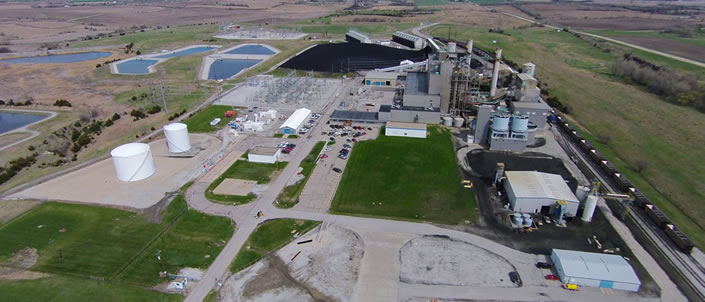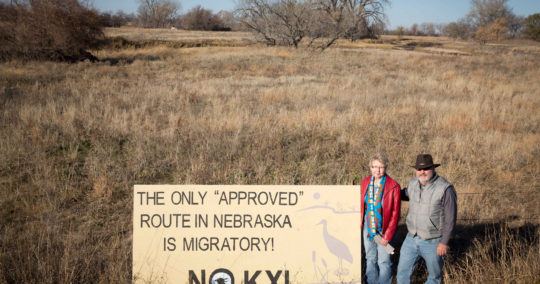



FOR IMMEDIATE RELEASE: Friday, April 17, 2015
Contact:
Jane Kleeb, 402-705-3622, jane@boldnebraska.org
Ken Winston, 402-212-3737, kwinston@inebraska.com
Bold Nebraska, Nebraska Sierra Club Statement on NPPD
Action to Reduce State’s Coal Dependence
Groups call for increased clean, renewable energy sources for Nebraska
Lincoln, NE — Bold Nebraska and Nebraska Sierra Club — two groups that represent thousands of Nebraskans who support clean energy in our small towns and large cities — react to Nebraska Public Power District’s (NPPD) announcement on Friday that will see our state further decrease its reliance on dirty coal-based energy.
“Relying on coal as our main source of energy puts Nebraskans at the mercy of out-of-state interests rather than building our own clean energy to fuel our homes, ranches and farms,” said Bold Nebraska director Jane Kleeb. “Bold Nebraska is optimistic NPPD is beginning to take steps towards low-cost and low-carbon energy alternatives rather than depending on coal. We urge NPPD to take leaps towards a clean energy future that protects our water, property rights and climate.”
“Although we appreciate NPPD taking steps to reduce the amount of coal they burn, we are very concerned about the process they used in reaching this decision,” said Ken Winston, Nebraska Sierra Club policy advocate. “They are a Public power district, not a private utility. The public should have had opportunities for engagement long before they made this announcement. We hope the energy generation process they unveiled today will reduce carbon emissions and other pollution. However, we need to make sure that NPPD provides opportunities for development of proven clean energy technologies such as solar, wind and energy efficiency which have a track record of economic and environmental benefits and can provide these benefits to communities throughout the state.”
NPPD on Friday said that it will replace an existing coal-fired burner at its Sheldon Station plant in Hallam, NE with one that uses hydrogen fuel — becoming the first large-scale utility operation to use the technology.
NPPD said the hydrogen boiler will produce zero greenhouse gas emissions, and also dramatically reduce other types of air emissions. The move will more importantly reduce Nebraska’s reliance on burning dirty coal, which currently provides around 70% of electricity to homes and businesses in the state, and is tied to increased asthma and other negative health impacts.
The action today by NPPD will also help move Nebraska closer to attaining its goal under President Obama’s Clean Power Plan, which targets coal-fired power plants that produce 30% of the country’s carbon emissions.
We’re also encouraged by the recent action taken by Omaha Public Power District to reduce reliance on coal and invest in clean wind energy — another step that will help Nebraska reach its goal under the Clean Power Plan.
While our state’s public power utilities are taking steps to comply with the Clean Power Plan, the same cannot be said for our state’s leaders — as Gov. Ricketts has directed Nebraska to join other states currently suing to block implementation by the Environmental Protection Agency of the President’s plan to reduce pollution from coal.
This litigation is not just a waste of taxpayer dollars, it is further evidence that our state’s leaders are bought and paid for by the fossil fuel industry, and would rather do their bidding than take steps towards cleaner air and water, and healthier children.
# # #
NPPD to Cease Burning Coal at Sheldon Coal Plant Unit 2 Outside Lincoln
Sierra Club Urges NPPD to Commit to Full Shift Away from Coal
Through Clean Energy Investment in Wind, Solar and Energy Efficiency
Contact:
Emily Rosenwasser, Emily.Rosenwasser@sierraclub.org, 312-251-1680 x119
HALLAM, NE – Today, Nebraska Public Power District (NPPD) announced it would cease burning coal at Unit 2 of its Sheldon Station coal-fired power plant in Hallam. NPPD will now burn a new hydrogen fuel at Unit 2 of the coal plant while continuing to burn coal in Unit 1. Built in 1958, Sheldon Station sits just south of Lincoln near the town of Hallam. The plant is owned and operated by NPPD and has contributed to air and water quality issues for the surrounding community.
“Starting the shift away from coal is an important first step for NPPD to reduce its pollution,” said Graham Jordison, Field Organizer with the Sierra Club Beyond Coal campaign in Nebraska. “However, the fact remains that NPPD will continue to burn coal from a unit at the Sheldon coal plant. We have proven low-cost, job-creating clean energy potential like wind and solar right here in Nebraska, and NPPD should have considered this through a robust public process of comparing zero-carbon alternatives. We urge NPPD to continue what it started today and complete a thorough evaluation of its opportunity to invest in modernizing the way we get our power by committing to shift away from coal to clean energy.”
NPPD customer-owners face high costs for the utility to import coal every year. NPPD is still heavily dependent on coal-fired power plants, and according to a Union of Concerned Scientists report, Nebraska already ranks fourth in the nation in coal imports per capita, spending $203 each year on imported coal for every man, woman and child in the state.
According to a recent Omaha World Herald investigation, Nebraska’s rates have soared in recent years while rates in neighboring states like Iowa drop.
According to the U.S. Environmental Protection Agency’s Toxic Release Inventory, Sheldon Station is the second largest source of toxic pollution in Lancaster County, and accounts for more than a third of Lancaster County’s toxic pollution. According to a detailed investigation by the New York Times, Sheldon Station committed 147 Clean Water Act violations between 2004 and 2008, the fourth highest number of violations of any power plant in the nation at that time, suggesting persistent and unabated water pollution from the plant.
The industrial process for producing the new hydrogen fuel is new, with questions remaining around air and water emissions, energy intensity and the cost of the project as it relates to other zero-carbon energy resources.
“As other states embrace clean energy like wind and solar and see big cost-savings, rates for Nebraskans are going up,” said Jordison. “If NPPD’s coal unit conversion at Sheldon Station is truly state-of-the-art, we expect meaningful public engagement around the plant’s new pollution permits. Sierra Club is encouraged that NPPD is ready to invest in zero-carbon energy resources, but NPPD must compare an experimental technology like the one at Sheldon head-to-head with well-proven wind, solar and energy efficiency. Careful and responsible energy investments are among NPPD’s highest duties.”



